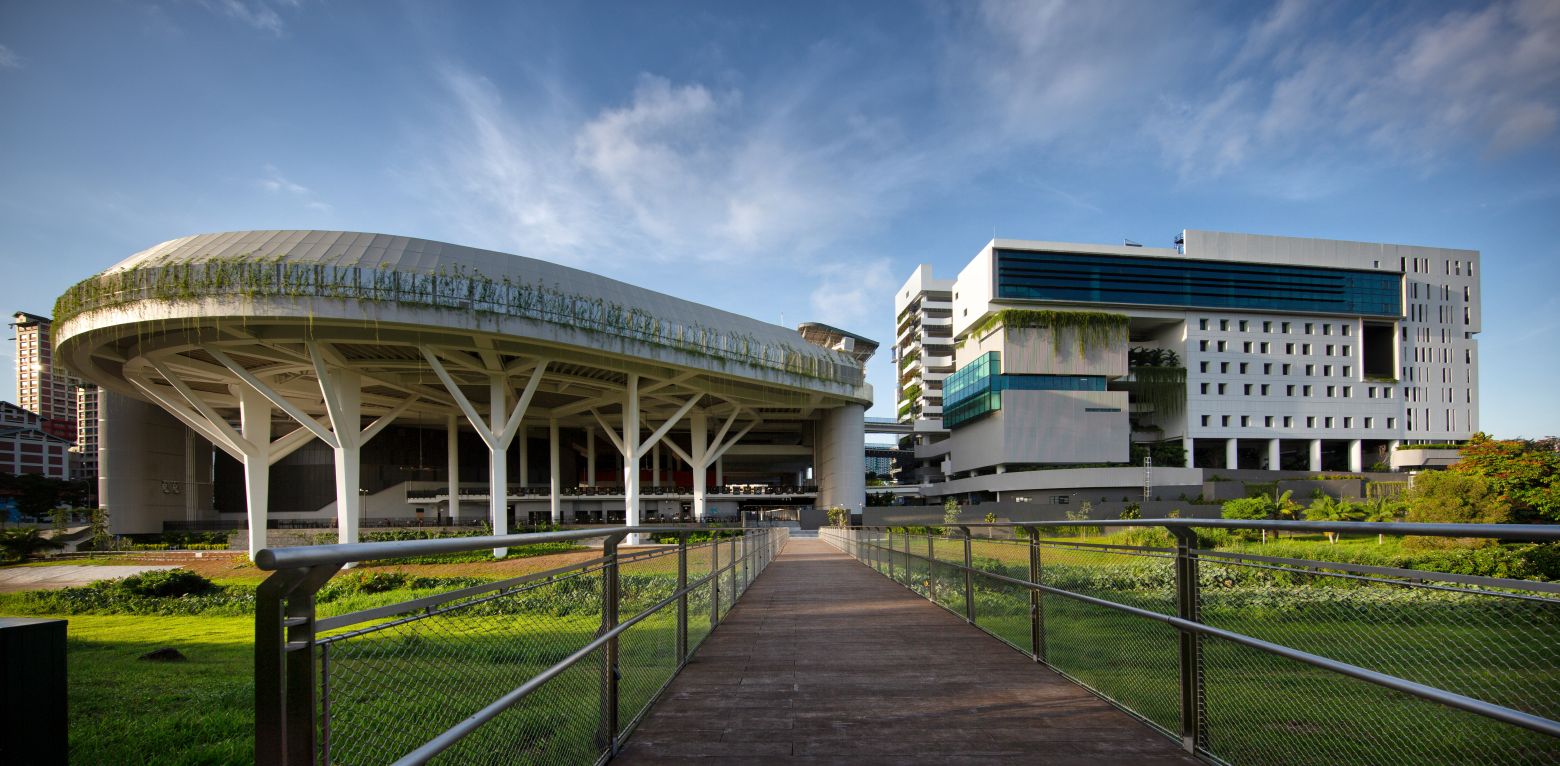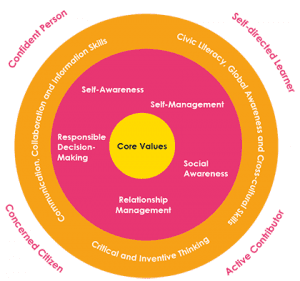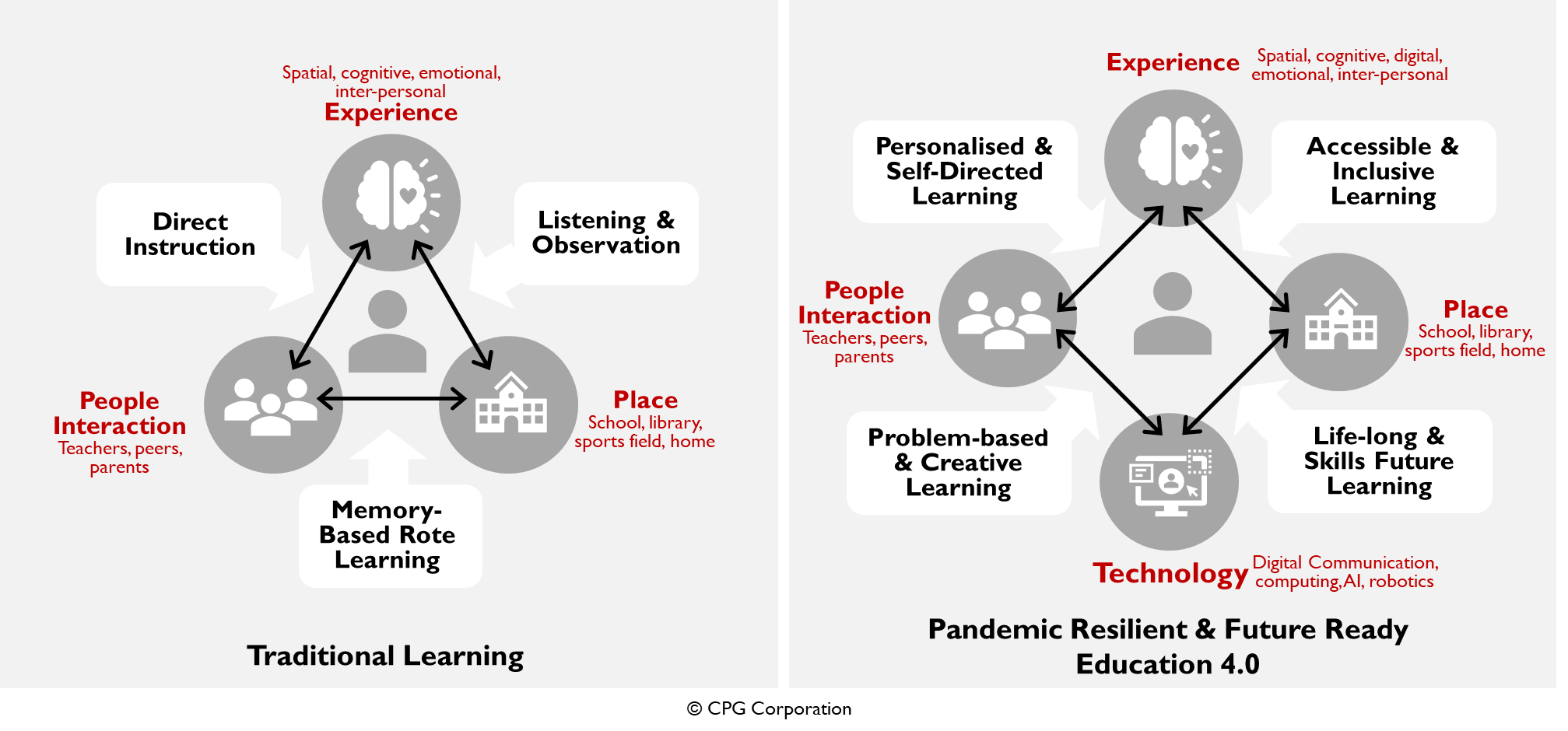
Eunoia Junior College, Image Credits: Ministry of Education (MOE) Singapore
Every education provider seeks to nurture individuals to not only further develop their strengths but also to develop certain desirable outcomes at the end of their formal education. In Singapore, based on the Ministry of Education’s “Framework for 21st Century Competencies and Student Outcomes”, education seeks to equip each individual with a good sense of self-awareness, a sound moral compass, and the necessary skills and knowledge to take on the challenges of the future. They should also be confident people, self-directed learners, active contributors and concerned citizens. This framework is built upon the core values of “Respect, Responsibility, Integrity, Care, Resilience and Harmony”.
Framework for 21st Century Competencies and Student Outcomes (Image Credit: MOE Singapore)
COVID-19 has certainly impacted every facet of society and brought with it varying degrees of change. How has the pandemic accelerated change in education pedagogy and how will education providers continue to adapt to be future-ready for other pandemics? To address that, we would suggest that three pertinent key questions be asked:
- How would the pandemic affect the desire outcome of education? Are we able to identify both negative and positive effects?
- What are the post-pandemic measures that must be implemented to mitigate and overcome negative factors to achieve the desired outcome of education?
- What are the means to amplify the positive post-pandemic effects on the desired outcome of education?
Two Primary Effects
The need for social distancing has led to two inter-related effects:
(1) Home-based or distant learning
(2) The use of digital platforms to connect teachers and students.
While these two are inter-related, the issues arising from the two require a different focus.
Home-based Learning
As we have recently experienced, lockdowns lasting months have required educational institutions to close on-premise lessons during a pandemic. However, education cannot stop. Education providers have hence been accelerating and reinforcing home-based learning.
From the student perspective, this has had negative social and psychological effects. Students may no longer have that sense of structure and stimulation that is provided by the school environment. Prolonged lack of physical social interaction may cause experiences of loneliness and stunted growth; leading to anxiety, fear, depression, social phobias, social awkwardness and a sense of cultural alienation.
Besides, for students that rely more on experiential learning, home-based learning is more challenging and may be an obstacle to their learning & development. Experiential learners often find the necessity for face-to-face interaction to form communities for collaborative learning. Some may need more intensive guidance where one on one sessions with a teacher are required.
On the other hand, reduced physical school time may also reduce negative effects like exposure to peer pressure and bullying. For students who are already independent and self-motivated, home-based learning hones their organisational skills and discipline, making them even more eager to learn.
From the parent or family perspective, home-based learning has a great potential to create a stronger family bond, on the conditions that parents are able to adapt and develop new skill sets to manage and guide their children. Instead of focusing more of their time on schoolwork and activities, student focus shifts more towards learning life skills. Socialisation is in turn centred on the family, across multiple generations if they are living with grandparents.
On the other hand, families have also struggled to cope; with parents having to juggle between their jobs and the supervision of their children. Flexible work arrangements and detailed schedules for children help significantly in time management for all within the household. Without a teacher’s constant supervision like at school, parents become de facto teachers needing to be more resourceful in guiding and answering their children’s study queries. Parents are also often forced to solve IT connectivity issues and login problems that can be frustrating and time-consuming.
From the teacher’s perspective, to keep the students engaged, there is additional planning required in the sequencing of topics, the pace of coverage and the choice of pedagogy based on the students’ learning needs. Only by increased engagement with parents, will teachers better understand the learning needs of students, as monitoring of students’ progress is limited to online participation and submission of assignments. For some teachers, there will be added pressure to improve their communication techniques and IT skills to be able to deliver convincing and engaging learning material digitally. The immediacy of instruction and answer to queries is also slowed with a teacher’s attention split between students through the use of instant messaging compared to a group classroom environment.
Digital Learning and the Digital Divide
The key concern here is to provide a conducive home-learning environment with adequate IT equipment and support. Low-income families are at a disadvantage with smaller cramped homes, without suitable furniture and IT equipment. The IT infrastructure needs to support sufficiently fast broadband speeds with broadband plans that are easily accessible and affordable. In Singapore, the Infocomm Media Development Authority (IMDA) runs the NEU PC Plus programme that offers low- income households the opportunity to own a computer at a subsidised rate and a free broadband subscription for three years. The Ministry of Education had also loaned to students approximately 12,500 laptops or tablets and 1,200 Internet enabling devices during the recent Circuit Breaker period. In short, the reduction in physical interaction time and emphasis on self-directed learning affects individual students, parents, and teachers differently, and the differences may be rather drastic. Depending entirely on home-based learning does not appear to be the solution, and some form of mitigation is required to achieve a balance between safe distancing to minimise transmission risks and physical social interaction to facilitate positive educational outcome.
Mitigating Factors
Peer interaction is required to learn cultural norms. Learning how to act around peers in physical, social setting is human nature, and cannot be replaced by online interaction. Hence, we advocate that new social norms, behaviour patterns, and operation models for schools have all to be reconsidered.
We need to go beyond conventional thinking about student density in schools, in terms of students per Gross Floor Area (GFA) when providing meeting safe distancing requirements. The curriculum, pedagogy, and design of schools require a new model based on activity density, where students are separated into smaller groups based on their activities. With a distributed model where students split their learning time, say, 50% at home and 50% at school, the risk of contagion is also reduced.
As resilience embraces a sense of elasticity, i.e. the ability to ‘stretch’ or adapt to a range of conditions, the design of schools needs to be reimagined to embrace a distributed model. In such a model, education institutes adopt a hybrid pedagogy that balances the best of both worlds: physical, on premise education, as well as digital learning. This model allows education programmes to respond to varying pandemic and health conditions, without adverse impact on the education outcome. If anything, one of the new outcomes that the model may bring would be to imbue the students, their families, and the teaching community with the quality of resilience.
New Focus Areas for Online Learning
With learning activities moving online, it is possible to refocus on the social behaviour of students. The online platform allows the creation of larger social networks, not limited to the confines of the school environment, involving the greater community.
As more activities move online, a new cultural norm may emerge, requiring new skills in relationship management. Students may become more self-aware and adapt to take full advantage when socialisation opportunities present themselves; leading to higher quality friendships.
Advances in Virtual Reality (VR) technology may help bridge the social interaction gap during mandatory home-based learning. For younger children, parents may also act as virtual online playdates.
New Focus Areas for On-premise Learning
With a Distributed Model of learning, the time spent at school has to be maximised with learning pedagogy that cannot be provided through online learning. Emphasis is made for one on one instruction, collaborative & hands-on learning, and physical activities.
All of the above-mentioned are of course made secured through safe distancing, working in small groups, staggered start and end of school timings and contact tracing.
Amplifying the Positive
As 21st century competencies are linked with technology, we should view the forced adoption of home-based learning as an opportunity. Such a form of learning had been technologically ready for a while, but social and individual behavioural changes were taking place at a much slower pace. Now that the behaviour change has taken place, we should see how we could leverage on it to build up the 21st century competencies. Without a doubt, the importance of independence and self-management has come to the fore. Other essential skills to hone are communication, collaborative approaches, and information skills.
As we rely more on technology to compensate for social connectivity, there is a possibility of social networks and groupings blurring; a school community may be expanded to include national kinship and even more, eventually reaching global affinity.
The importance of the study of Science Technology Engineering Maths (STEM) subjects are highlighted as developments in these areas, meant to help overcome the limitating factors of a pandemic.
The above also cultivates character development and develop critical and inventive thinkers. A general population with these intrinsic values will most certainly benefit any nation; being able to foresee and better respond to threats and seizing opportunities to reap sustainable socio-economic benefits.

Conclusion
To ensure that the desired outcomes of education are achieved post-pandemic, it will take time to adjust with careful attention and planning, to obtain the right mix of home-based learning and learning within the physical school environment. The challenge is to seize the opportunity created by the necessary accelerated changes to the 21st century education pedagogy caused by this pandemic, with the objective of developing adaptive individuals that can survive and succeed whilst keeping their core values intact in this ever-changing digital age.
In CPG, we are mindful of the transitional challenges and obstacles, but at the same time, we are also excited by the potential and opportunities that the positive changes will bring to the education sector. We believe one of the many ways forward is the integration of technology and the built environment. With our Smart Nation vision, all our citizens are digitally savvy and enabled, all future homes are smart homes, and all educational facilities will be pandemic-resilient smart campuses. We shall share more about these topics in future blogposts.
This article was authored by:
Ar. Tan Pheng Chee, Senior Vice President
Architecture Group, CPG Consultants Pte. Ltd
tan.pheng.chee@cpgcorp.com.sg
Ar. Yong Fen Bok, Vice President
Architecture Group, CPG Consultants Pte. Ltd
yong.fen.bok@cpgcorp.com.sg


